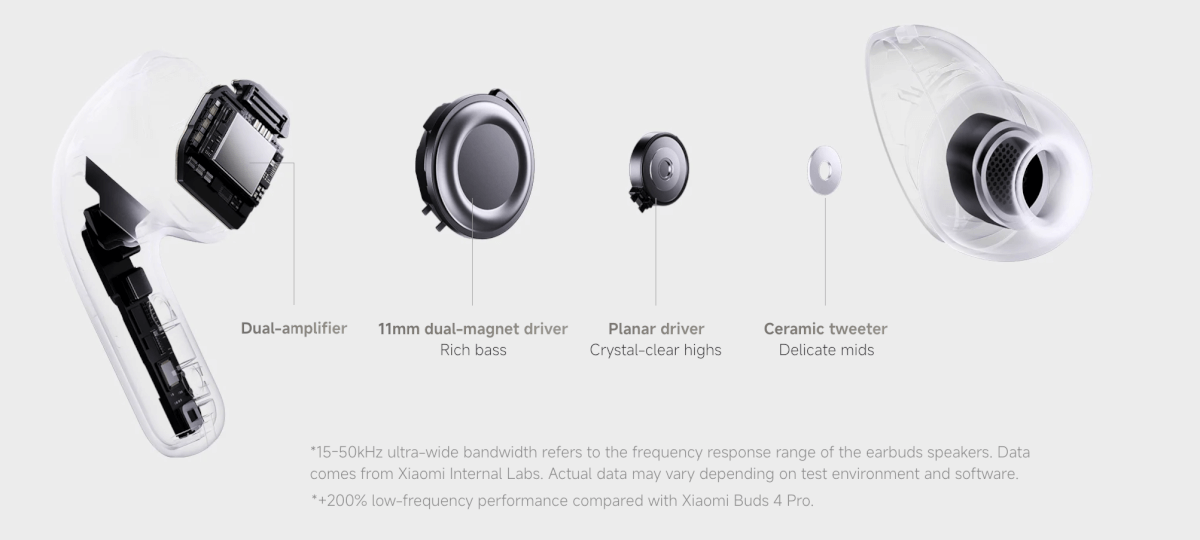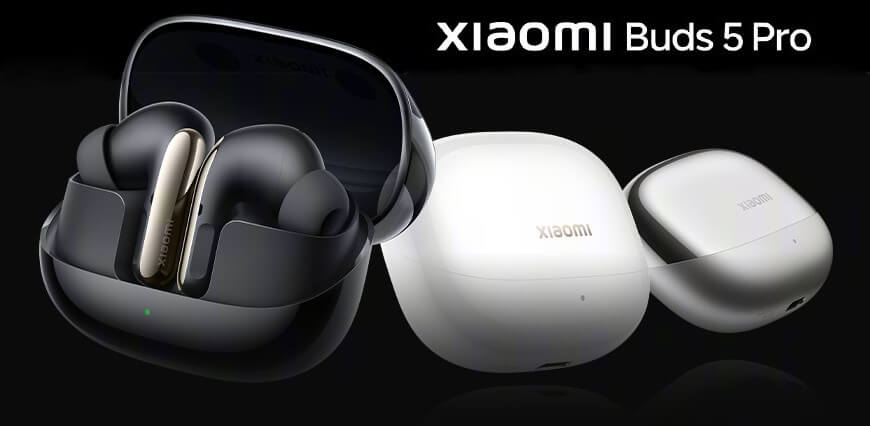
Xiaomi has unveiled new in-ear TWS headphones – Xiaomi Buds 5 Pro. Not to be confused with the Redmi Buds 5 Pro and the new Redmi Buds 6 Pro (which are almost 4 times cheaper, at $60, against Xiaomi’s $220), these are different models. Redmi is the more budget sub-brand, while Xiaomi is the more expensive mainstream premium brand. The logic goes like this.
The main differences from the previous version of Xiaomi Buds 4 Pro: 3 audio drivers instead of one, support for Qualcomm aptX Lossless codec with bitrate up to 2.1 Mbps, voice recorder and simultaneous translation function. Audio customization with Harman’s team of Golden Ear experts. Separately available version of Xiaomi Buds 5 Pro Wi-Fi wireless headphones with XPAN support and bitrate up to 4.2 Mbps.
The Xiaomi Buds 5 Pro in-ear wireless headphones have dual power amplifiers and three drivers for sound. And both amplifiers separately control bass and treble frequencies to reduce distortion. The sound system consists of an 11mm dual-magnet dynamic driver like the Xiaomi Buds 4 Pro, as well as a ceramic tweeter and planar driver. The Bluetooth headphones can reproduce sound in the frequency range of 15Hz – 50kHz.

The headphones support only 3 codecs: SBC, AAC and aptX Lossless with bitrate up to 1.2 Mbps. The previous generation had 4 codecs: SBC, AAC, LHDC 4.0 and LDAC. The Wi-Fi version of the headphones additionally supports Qualcomm XPAN technology with bitrate up to 4.2 Mbps. At the same time, you can not so easily take and listen to music in 24 bit / 96 kHz quality. At the time of publishing this news, the maximum bitrate can be selected only in the Xiaomi 15 Ultra phone. Bitrate up to 2.1 Mbps is available in Xiaomi 15 Pro, Xiaomi 15, Xiaomi MIX Flip and Xiaomi MIX Fold 4 phones. And for owners of REDMI K80 Pro, REDMI K80, Xiaomi Pad 7 Pro, Xiaomi 14 Ultra, Xiaomi 14 Pro, Xiaomi 14, Redmi K70 Pro, Redmi K70 only bitrate up to 1.2 Mbps. The manufacturer promises to expand the list of supported models without announcing exact dates. Important! Some functions will stop working if you transmit audio via Wi-Fi: spatial audio, connection to two devices, firmware update, etc.
In general, the technology of audio transmission over Wi-Fi looks very interesting, but it is not clear yet how much it is a viable idea and whether it makes sense. We’ll see.
With the voice recorder function, you can record calls, phone sound and ambient sound. You do not have to remove the headphones from the case to record. The maximum recording duration is 4 hours. Supports face-to-face translation (live dialog with the person next to you) and simultaneous interpreting with ≥98.7% accuracy.

For conversations, there are 3 microphones in each earpiece, and the noise canceling function blocks noise up to 100dB, and there is an anti-wind function. The Adaptive Noise Reduction depth has increased from 53dB to 55dB and the bandwidth has increased to 5kHz. You can customize the adaptive noise cancellation in the Xiaomi Earbuds branded app for Android and for iOS. Also in the branded app you can assign controls, enable spatial audio, etc. There are useful sound parameters – effects setting, adjustable equalizer with ready-made presets, etc. You can also appreciate the fruits of cooperation with Harman Golden Ear experts in two proprietary EQ presets.
The Xiaomi Buds 5 Pro headphones have a runtime of 8 hours at medium volume and 40 hours with the case, while 10 minutes of charging in the case gives 4.5 hours of runtime. The Wi-Fi model is 10 hours on medium volume and 40 hours with the case, and 10 minutes of charging in the case gives 4 hours of use. The Bluetooth version has been updated from 5.3 to 5.4. The manufacturer promises audio lag in games up to 50ms. The weight of the earpiece is 5.6 g, the weight of the headphones with the case is 53 g. Xiaomi Buds 5 Pro headphones are available in gray and white colors, Buds 5 Pro with Wi-Fi – only in black with a transparent cover.
What are you interested in comparing this model to? Write in the comments.

